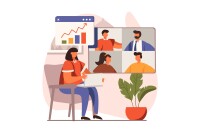Search
There are 12 results.
Tag
Tag
All (62)
Active Learning (2)
Activities (1)
Analytics (1)
Assessments (3)
Asynchrony (2)
Backwards Design (1)
Canvas (3)
Collaboration (3)
Communication (4)
Community (2)
Content Creation (15)
Copyright (2)
Course Maintenance (6)
Course Materials (8)
Course Preparation (5)
Discussions (1)
Diversity (1)
Faculty Presence (2)
Faculty Support (1)
Feedback (1)
Game-Based Learning (2)
Gamification (1)
Generative AI (2)
Images (3)
Inclusion (2)
Infographics (2)
Learning Objectives (2)
Multimodality (3)
Page Design (1)
PowerPoint (2)
Presentations (1)
Qualitative courses (1)
Quantitative courses (1)
Representation (2)
Revising (2)
Revision (1)
Rubrics (1)
Screen Readers (1)
Social Media (1)
Synchrony (3)
Third-Party Tools (1)
Universal Design for Learning (UDL) (2)
Video (13)
Visual Accessibility (2)
Visual Design (2)
Six Strategies for Multimodal Content Delivery
If you’re developing a course with synchronous and asynchronous elements, you have a host of options for engaging students and delivering content. Research suggests that incorporating multiple modalities increases accessibility, engagement, and learning (Mick and Middlebrook, 2015; Margolis et al., 2017). With that said, it is important to be intentional about multimodal course design. Both synchronous and asynchronous methods of delivery are effective, but activities can be better suited to one or the other modality and synchronous time is often limited. Delivering selected content asynchronously can support students’ understanding of how information is organized and leave more time for interactivity in synchronous sessions.
Improving PowerPoints
Sharing information via PowerPoint presentations is a long-established strategy in higher education. Designing PowerPoint presentations for online courses can pose unique challenges; however, best practices can help overcome these hurdles. With time and attention, faculty and instructional designers can create engaging and purposeful presentations with lasting value.
Multimodal Models
Designing a successful multimodal course means, at each step of the process, considering what each format does well—structuring the course such that each piece of content, each activity, and each interaction uses the most effective delivery method available. But what does that look like in practice? This piece describes three approaches to structuring a multimodal course. In each model, asynchronous and synchronous time complement one another and further module and course objectives. Where the models differ is in the relative importance of asynchronous activities in enabling students to complete synchronous activities and vice versa.
Accessible PDFs
Developing and delivering accessible instructional content—meaning content that students with and without disabilities can readily engage with and use—is essential to the success of an online course. While many accessibility standards and guidelines are broadly applicable, there are also specific considerations unique to different content formats and delivery modes. In this piece, we present recommendations for enhancing the accessibility of PDFs for students.
Leveraging Podcasts in Online Higher Education
Podcasts are digital audio that you can download or stream onto a computer or mobile device. They are convenient, portable, reusable, and do not require particularly high-tech devices or connections. They are also popular. According to a 2022 Infinite Dial survey, "Seventy-three percent of the U.S. 12+ population (an estimated 209 million people) have listened to online audio in the last month, up from 68% in 2021" (Edison Research, 2022). While podcast use declined slightly in 2022, returning to pre-pandemic levels, the medium is still burgeoning, with plenty of room for further growth.
Managing Files in Canvas
Students and instructors alike benefit from consistent file management in online courses. Ensuring that students can readily locate and access the files they need serves to promote engagement and completion of course requirements. Similarly, consistent file management helps instructors to navigate through and update materials efficiently and to avoid introducing file-related errors. This post outlines recommendations and key considerations for optimizing file management within your online course. While recommendations and considerations related to Canvas-specific functionality are threaded throughout, you will also find broadly applicable tips pertinent to multiple learning management systems.
Hyperlink Dos and Don'ts
When designing a course, you want to ensure that all students can access the websites and documents that you link. Accessible hyperlinks are particularly important for students with screen readers, which read the links out loud. This piece contains best practices for writing and formatting accessible hyperlinks so that all learners can access the content that you have curated for your course.
Inclusive Citation
Inclusive citation practices can empower educators to cultivate equity, enrich academic discourse, and create welcoming learning environments. By prioritizing diverse perspectives and ensuring the representation of underrepresented voices, instructors can address systemic inequities in scholarship and amplify marginalized contributions. Such efforts not only deepen students’ critical engagement with course materials but also foster a sense of belonging, preparing them to thoughtfully navigate an increasingly interconnected world.










